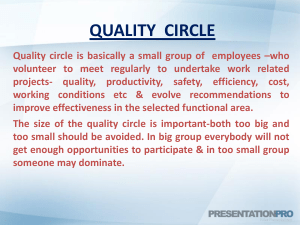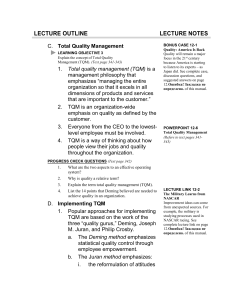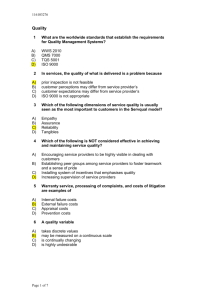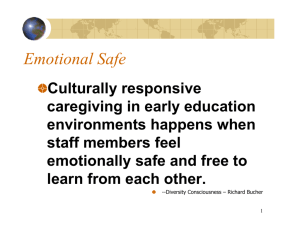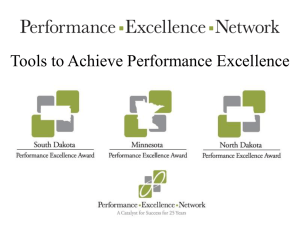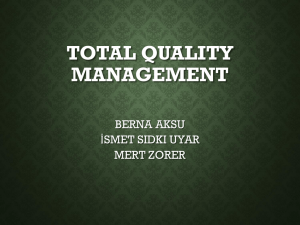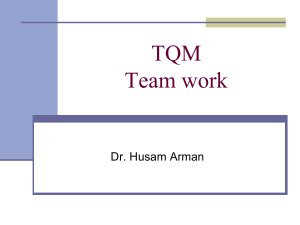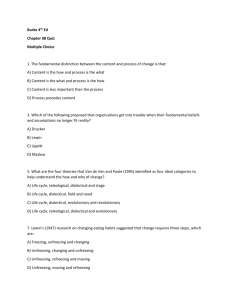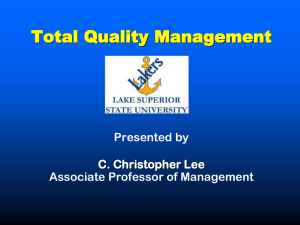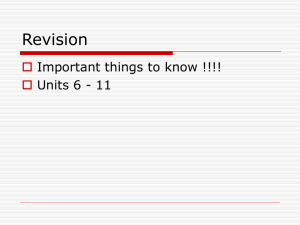Organizational Behavior
advertisement
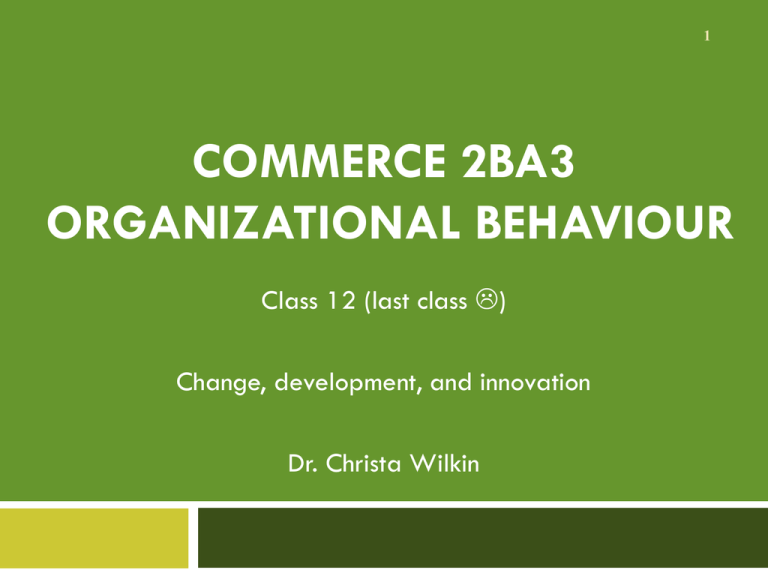
1 COMMERCE 2BA3 ORGANIZATIONAL BEHAVIOUR Class 12 (last class ) Change, development, and innovation Dr. Christa Wilkin Brain Teasers 2 ENTURY ECNALG working time I right I Last Class 3 One type of organizational structure is not better than the other Depends on internal and external environment Structure may change over time Organizations are open systems that are affected by and affect their environments THIS CLASS Change, development, and innovation Pre-Exam Review Agenda 4 What organizations can change Change process Organizational development Innovation Pre-exam review 5 CH 16: CHANGE, DEVELOPMENT, AND INNOVATION Some Quotes 6 He who rejects change is the architect of decay. The only human institution which rejects progress is the cemetery. ~Harold Wilson Change is inevitable - except from a vending machine. ~Robert C. Gallagher All change is not growth, as all movement is not forward. ~Ellen Glasgow What Organizations Can Change 7 Goals and strategies Technology Job design Structure Processes Culture People What Organizations Can Change 8 Three important points about the areas that organizations can change: Change in one area very often calls for changes in other areas. E.g., change policy affects how things are done elsewhere Change in most areas require serious attention be given to people. E.g., often resist change Change requires employees to learn new skills and change their attitudes. E.g., learn new computer software Lewin’s Three-Step Model 9 1. Unfreeze The recognition that some current state of affairs is unsatisfactory Employee attitude surveys, customer surveys, and accounting data are often used to anticipate problems and initiate change before crises are reached Lewin’s Three-Step Model 10 2. Change The implementation of a program or plan to move the organization or its members to a more satisfactory state. Change efforts can range from minor to major. Lewin’s Three-Step Model 11 3. Refreeze The condition that exists when newly developed behaviours, attitudes, or structures become an enduring part of the organization. The effectiveness of the change is examined and the desirability of extending change further can be considered. Issues in Change Process 12 Issues in the Change Process 13 There are several important issues that organizations must confront during the change process. These issues represent problems that must be overcome if the process is to be effective, and include: Diagnosis Resistance Evaluation and institutionalization Diagnosis 14 The systematic collection of information relevant to impending organizational change. Proper diagnosis clarifies the problem and suggests what should be changed and the proper strategy for implementing change without resistance. The intended targets of the change should be involved in the diagnostic process. Resistance 15 Change is frequently resisted by those at whom it is targeted. People may resist both unfreezing and change. Resistance to change occurs when people either overtly or covertly fail to support the change effort. Transformational leaders. Evaluation and Institutionalization 16 When the change is institutionalized, it becomes a permanent part of the organizational system. A number of factors can inhibit institutionalization, especially for complex change programs. Lack of extrinsic rewards. Higher expectations that cannot be fulfilled. New hires are not carefully socialized. Quiz Question 17 The Stinky Cheese Company has realized that its market share of cheese has recently dropped and it may need to create a new kind of stinky cheese. Which stage of the change process are they in? A) refreezing B) unfreezing C) perceived threat D) conflict E) resistance Organizational Development 18 Organizational development (OD) is a planned, ongoing effort to change organizations to be more effective and more human. E.g., team building, TQM, survey feedback Team Building 19 An effort to increase the effectiveness of work teams by improving interpersonal processes, goal clarification, and role clarification. It can facilitate communication and coordination. Team building usually begins with a diagnostic session that results in a list of needed changes to improve team functioning. Survey Feedback 20 The collection of data from organizational members and the provision of feedback about the results. Meetings are held to explore and discuss the data and to suggest changes. The data usually consist of interviews or questionnaires completed by organizational members. Total Quality Management (TQM) 21 A systematic attempt to achieve continuous improvement in the quality of an organization’s products and/or services. Continuous improvement can come from small gains over time or from more radical innovation. The goal is long-term improvement. Total Quality Management (TQM) 22 TQM involves specialized training in tools that empower ee’s to diagnose and solve quality problems on an ongoing basis. Some tools include: Flowcharts of work processes: illustrate graphically the operations and steps in accomplishing some task Pareto analysis: frequency data on the causes of errors and problems ; helps identify top 20% of causes that needs to be addressed to resolve 80% of the problems Total Quality Management (TQM) 23 Fishbone diagrams: illustrate graphically the root factors that could contribute to a particular quality problem Statistical process control: gives ee’s hard data about quality of own output that enables to correct deviations Reengineering 24 The radical redesign of organizational processes to achieve major improvements in factors such as time, cost, quality, or service. It asks basic questions, such as: “What business are we really in?” “If we were creating this organization today, what would it look like?” Jobs, structure, technology, and policy are redesigned around the answers to these questions. Does Org Development Work? 25 Most OD techniques have a positive impact on productivity, job satisfaction, or other work attitudes. OD seems to work better for supervisors or managers than for blue-collar workers. Changes that use more than one technique seem to have more impact. The Innovation Process 26 Innovation is the process of developing and implementing new ideas in an organization. Innovation requires: Creative ideas and creative people. People who will fight for new ideas. Good communication. The proper application of resources and rewards. Creativity refers to the production of novel but potentially useful ideas. Idea Champions 27 Idea champions are people who see the kernel of an innovative idea and help guide it through to implementation. The role of idea champion is often an informal and emergent role. It involves sponsorship and support. Communication 28 Effective communication with the external environment and within the organization are vital for successful innovation. Innovative firms recognize the relevance of new, external information, importing and assimilating it, and then applying it. Gatekeepers are people who span the boundary between the organization and the environment. They import new information, translate it for local use, and disseminate it to project members. The Knowing-Doing Gap 29 Many managers know what to do, but have considerable trouble implementing this knowledge in the form of action. Why does the knowing-doing gap happen? The Knowing-Doing Gap 30 The tendency for some organizational cultures to reward short-term talk rather than longer-term action. Many organizations foster internal competition that is not conducive to the cooperation between units that many changes require. When managers do manage to make changes, they sometimes fail because techniques are adopted without understanding their underlying philosophy. Exercise: Infomercial 31 Form groups of 5 to 6 people Each group will get a prop and it is your job to come up with an one-minute infomercial Be prepared to act out your infomercial to the class 32 QUESTIONS? Summary 33 It is important to manage the change process: Too much change may not be good and too little change can be bad Pre-Exam Review 34 Ch 10: Communication Ch 11: Decision Making Ch 12: Power, Politics and Ethics Ch 13: Conflict & Stress Ch 14: Organizational Structure Ch 15: Environment, Strategy, Technology Ch 16: Change, Development, Innovation For Next Class 35 Make an appointment if you need more help for the final exam


